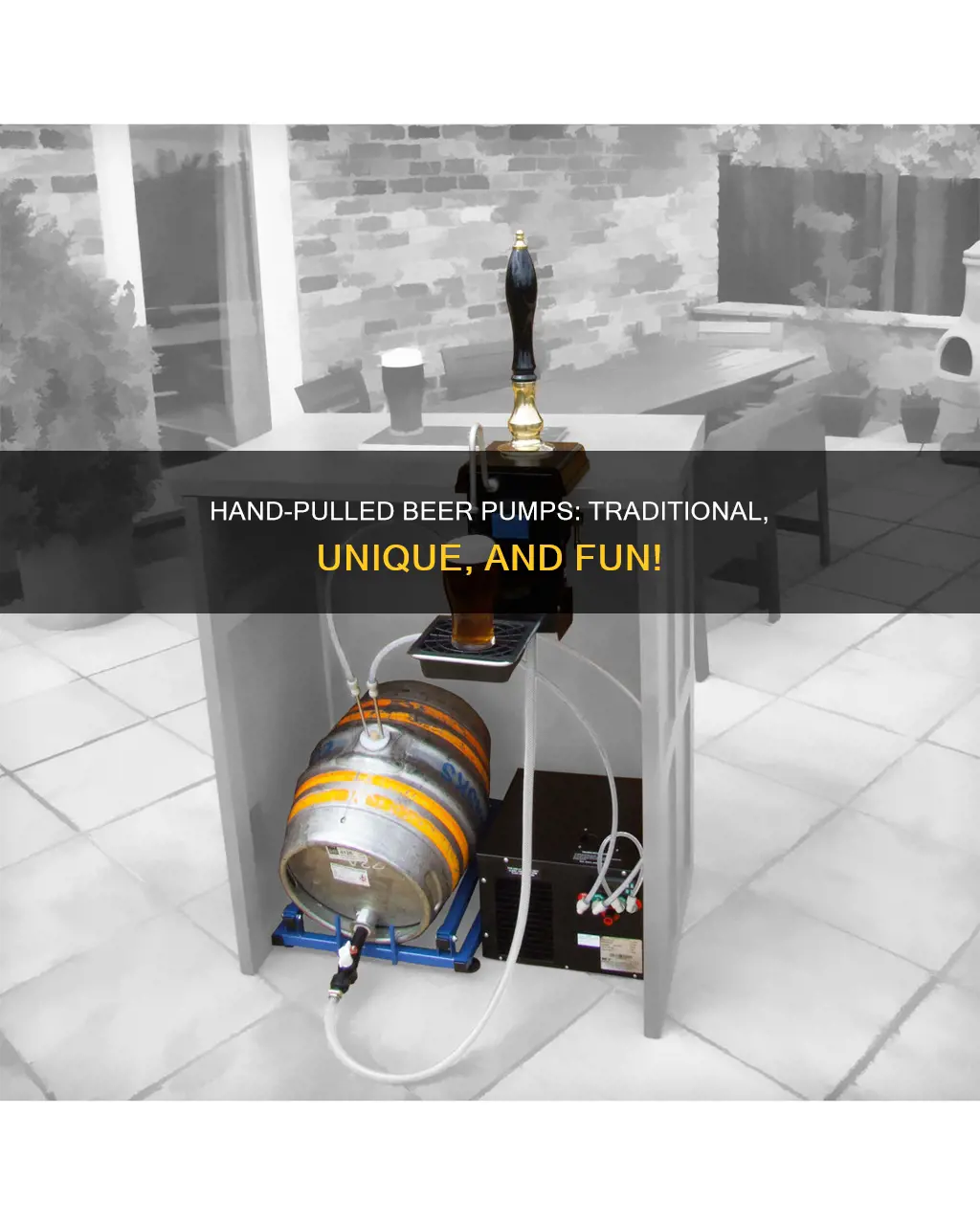
The hand-pulled beer pump, also known as a beer engine, is a device used to pump beer from a cask, usually located in a pub's cellar. Invented by John Lofting, a Dutch inventor, the beer engine was patented in 1691 as a very useful engine for starting of beers and other liquors. Today, the device is manually operated, with the term handpump referring to both the pump and the handle. The beer engine is typically located below the bar, with the handle used to draw the beer through a flexible tube to the spout above the glass. The basic principle of the hand-pulled beer pump is to use mechanical force, rather than gas pressure, to deliver beer to the faucet, maintaining the ideal balance of flavours in cask-conditioned ales.
| Characteristics | Values |
|---|---|
| Purpose | To move beer from the keg to the faucet |
| Mechanism | Mechanical force, not gas pressure |
| Beer Type | Traditional cask-conditioned ales |
| Location | Below the bar |
| Power | Manually operated, or electrically/gas powered |
| Parts | Cylinder, piston, check valve, beer line |
| Function | Beer is drawn from the cask into the piston when the handle is pulled |
| Maintenance | Regular cleaning to prevent build-up and germs |
What You'll Learn

Beer engines are piston pumps that allow casks to be kept cool in a cellar
Beer engines, also known as hand pumps, are devices used to pump beer from a cask. They are typically found in pubs, where the casks are stored in a cool cellar below the bar. The beer engine was invented by John Lofting, a Dutch inventor, merchant, and manufacturer who moved to London around 1688. He patented several inventions, including a fire hose and engine for extinguishing fires.
A beer engine is a piston pump that allows the casks to be kept cool in a cellar. This is particularly important for cask-conditioned ales, which have lower carbonation levels than standard beers and are typically served at a cooler temperature of around 11°C to 14°C (52°F to 57°F). By keeping the casks in a cool cellar, the beer engine helps maintain the ideal balance of flavours in the beer. If cask-conditioned ale is served through a standard dispensing system, the colder temperature and increased gas pressure would alter the carbonation levels, impacting the taste and quality of the beer.
The beer engine uses mechanical force to draw the beer from the cask to the faucet, eliminating the need for gas pressure. This is especially useful in beer line systems where longer runs or significant vertical lifts are required, as gas pressure can cause issues in these situations. The beer engine consists of a simple piston attached to a long, sturdy handle. When the handle is pulled, beer is drawn from the cask into a glass. Check valves ensure that the beer flows in one direction only, upwards from the cask to the glass.
The modern beer engine has changed little since the early 1800s, and it is typically designed to dispense a half or a quarter (Imperial) pint per pull. Operating a beer engine requires skill and physical strength, as it involves repeatedly pulling the long handle. Experienced bartenders alternate between using their right and left arms to avoid the "barman's bicep," where one arm becomes noticeably larger than the other.
Beer Sales Strategies During Doubleheaders
You may want to see also

Beer is drawn from a cask into a piston via a tap
The beer engine, also known as a hand pump, is a uniquely British device used to draw beer from a cask, usually located in a pub's cellar. Invented by John Lofting, a Dutch inventor, the beer engine was patented in 1691 and further developed by Joseph Bramah in 1797.
The beer engine consists of a piston pump that allows beer to be drawn from the cask into a glass. The cask resides on a stillage and has a hole for common air to enter and replace the beer as it is drawn through a tap. The tap is hammered into the cask with a rubber mallet, and the beer line connects the cask with the hand-pull beer pump engine.
When the handle of the beer engine is pulled down, beer is drawn out of the cask and into the piston via a tap. The airtight piston chamber ensures a strong, foam-free flow of beer. The beer then flows through a flexible tube to the spout, where it is dispensed into a glass.
The beer engine is typically located below the bar, with the visible handle used to draw the beer. Modern hand pumps may be clamped onto the edge of the bar or mounted on top of it. A pump clip attached to the handle usually provides information such as the name of the beer, the brewery, the beer type, and the alcoholic strength.
The beer engine is specifically designed for traditional cask-conditioned ales, which have lower carbonation levels than standard beers due to being served at cooler temperatures. Using a standard dispensing system for cask-conditioned ales would increase the carbonation and alter the balance of flavors. Therefore, the beer engine is essential for maintaining the ideal flavor profile of these ales.
Antibiotics and Beer: A Safe Mix?
You may want to see also

Beer pumps are powered by high-pressure gas or compressed air
A beer engine, also known as a hand pump, is a device for pumping beer from a cask or keg. It was invented by John Lofting, a Dutch inventor, merchant and manufacturer, in 1688. The beer engine is usually manually operated, but electrically powered and gas-powered pumps are also used.
If a system uses compressed air, it should never come into contact with the draught beer. It is also important to use a high-quality air compressor to clean and dry the air, avoiding damage to the beer pump. Smaller, cheaper air compressors may deliver air that still contains small amounts of moisture and oil, which can eventually damage the pump.
The basic purpose of the beer pump is to move beer from the keg or another container to the faucet. This is an alternative to using gas pressure to move the beer. The pump uses mechanical force to deliver the beer to the faucet. Beer pumps are commonly found in beer line systems where more than 35 or 40 psi is needed to create a consistent flow.
The pump works by connecting to two different sources of pressure: CO2 pressure on the keg to maintain beer carbonation (12-14 psi), and separate gas pressure (20+ psi) running through the pump itself to propel the beer. The pump can receive pressure from either CO2 or dry compressed air, depending on your preference.
The Chemistry of Beer: How It Works and Why It Matters
You may want to see also

Fixed and additive pressure are the two basic types of beer pumps
A beer engine, also known as a hand pump, is a device for pumping beer from a cask, usually located in a pub's cellar. The basic purpose of the beer pump is to move beer from the keg or other container to the faucet. Beer pumps essentially come in two basic types: fixed pressure and additive pressure.
It is becoming harder to find a fixed pressure pump. This is because a fixed pressure pump only delivers beer at the same pressure that is being applied to the keg. An additive pressure pump is usually found in long-draw systems because the keg's applied pressure is in addition to the gas pressure that moves the beer through the pump. An additive pressure system can still pump beer, however weakly, if it fails, which is something a fixed system cannot do.
When using additive pressure type pumps, set the pump pressure so that the sum total of the keg pressure plus pump pressure equals the system resistance pressure. Beer pumps should be installed below the level of the faucet at the bar and less than 5 feet above the cooler floor height.
The beer engine was invented by John Lofting, a Dutch inventor, merchant and manufacturer who moved from Amsterdam to London in about 1688. The London Gazette of 17 March 1691 stated that Lofting had "projected a very useful engine for starting of beers and other liquors which will deliver from 20 to 30 barrels an hour which are completely fixed with brass joints and screws at reasonable rates."
Understanding Three-Burner Brewing: An Efficient Beer System
You may want to see also

A beer engine is also known as a hand pump
A beer engine, also known as a hand pump, is a uniquely British device used to dispense beer. It is manually operated and works by using mechanical force to draw beer from a cask, typically located in a pub's cellar, up to the bar. This mechanism is particularly suitable for traditional cask-conditioned ales, which have lower carbonation than standard beers due to their serving temperature of around 11°C to 14°C.
Invented by John Lofting, a Dutch inventor who moved to London in 1688, the beer engine was further developed by Joseph Bramah in 1797. The modern beer engine consists of a piston attached to a long, sturdy handle, with check valves ensuring that beer flows in one direction, from the cask to the glass. The beer engine is usually located below the bar, with the visible handle used to pull the beer through a flexible tube to the spout above the glass.
The process of drawing beer using a beer engine is straightforward. When the handle is pulled down, the beer is drawn from the cask into the piston and then dispensed into the glass. To achieve a strong, foam-free flow, the handle may need to be pulled multiple times, depending on the length of the beer line. A standard beer engine dispenses about 1/2 pint of beer per pull, so two solid pulls are usually sufficient to fill a pint glass.
Beer engines are generally reliable and require little maintenance. They are favoured for their ability to preserve the flavour of cask-conditioned ales, as using gas pressure to dispense these beers would increase carbonation and alter the balance of flavours.
The Magic of Beer Guns: Filling and Foaming Perfection
You may want to see also
Frequently asked questions
A hand-pulled beer pump, also known as a beer engine, is a device for pumping beer from a cask, usually located in a pub's cellar.
A hand-pulled beer pump uses mechanical force to deliver beer to the faucet. When the handle is pulled down, the beer is drawn out of the cask into the glass.
Hand-pulled beer pumps are specifically appropriate for traditional cask-conditioned ales. Cask-conditioned beers have lower carbonation than standard beers because they are usually served at about 11°C to 14°C.
Hand-pulled beer pumps allow the casks to be kept in a cooler cellar below the bar and the beer to be pulled or drawn up to the bar. This helps to maintain the ideal balance of flavors in the beer.







